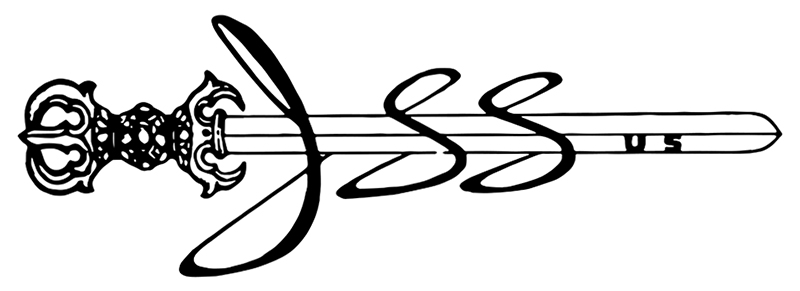
The articles on this page originally appeared in JSSUS newsletter Volume 48, no.5, 2016.
CURATOR or COLLECTOR? A RIPOSTE by James L. McElhinney - Page 6
Volume 48, no.5, 2016
CURATOR or COLLECTOR? A RIPOSTE
On page 5 of the March-April 2016 JSSUS Newsletter, John Eliyas posed the question,
“What do you do, curate or collect?”
I'm hoping the answer is “both”.
By virtue of their callings, collectors and curators are enthusiasts. Let’s look at the differences, and what they have in common. A curator is an authoritative collections manager, a trained scholar who oversees the storage and interpretation of objects, organizes exhibitions, produces publications and hosts symposia. A collector might describe anyone who accumulates anything, from wingnuts to Old Master paintings. A serious collector might be anyone focused on a specific kind of object, technique or time period and who pursues his interest in a studious, disciplined way.
A significant collector also is someone who engages in scholarship, publications and exhibitions, or supports research and interpretation within his field of interest via charitable contributions to universities and museums. A significant collector is not just someone with a significant collection but someone who makes a durable contribution to their field.
The differences between collectors and curators merge around the objects, techniques and time period upon which both are focused. A significant collector thus is also a curator, steward, museum registrar and philanthropist. For example, the Metropolitan Museum of Art is like the city it serves; a concatenation of villages. Each curatorial village has a collectors’ circle—an independent advisory group that both supports and influences the conduct of the department it benefits. This is different from a straightforward museum membership, which is voluntary.
Membership into a collectors’ circle is invitational, and thus very exclusive. The base-level annual buy-in for some museum departments like American Art might be $25K, with leading patrons committing hundreds of thousands, if not millions. Members with more modest means are motivated by the Three G’s (Give, Get or Get out) to raise money from other sources. A collectors’ circle member at the $25K level might solicit and gather donations from others hopeful of being invited to join the elite company. This is how significant collectors are recognized by the real (art) world.
Readers may ask how I come to know such things. The answer is simple. I have made a living in the art world for more than forty years, produced more than forty solo exhibitions of my own artwork, published several books and conducted scores of oral history interviews for the Smithsonian and other institutions with leading museum directors, curators, collectors, art dealers, critics and historians. My wife is a distinguished art historian connected to the highest levels of cultural philanthropy. We are far from rich but do collect certain things in depth, on a modest scale. Every year we make charitable donations to various worthy institutions. For example, I make annual donations to the Arms and Armor Department at the Met, earmarked to support the work of Mr. Ogawa in the acquisition, care and maintenance of its collection of Japanese arms and armor. Whenever Mr. Ogawa retires, I will continue to support the department with my annual contribution. It’s the way things are done. It’s the right thing to do. It’s also how museums know to take you seriously.
Supporting local, regional or national museums as a way to promote interest in any field of art. Creating scholarships to support doctoral dissertations administered through a university of one’s choice, or providing subventions to support the publication of new books and articles are effective ways to promote interest in any field of study and collecting.
Alternately, collectors with limited means might become authors in their own right, publishing research related to their areas of collecting. Those who have made significant contributions to Japanese arms and armor as published authors include Henri Joly, Charles Boxer, the late Masayuki Sasano, Robert Haynes, Robert Benson, Leon Kapp, Markus Sesko and many many others. Most non-academic fields of art-historical practice rely on connoisseurs for their intellectual capital.
Becoming patrons of the arts may be daunting to many individuals, but study groups and sword clubs—especially if they are registered nonprofits with money in the bank—are well-positioned to make donations to support museums, or raise money for new publications and scholarship that will make Nihonto more accessible, and thus attract new collectors.
When undertaken in a spirit of good will, without the taint of obvious self-interest, individuals and organizations that support scholarship, museums, publications, exhibitions, and other charitable activities can draw new people into a field, create a more competitive buying environment and thus enhance if not raise the value of existing collections. This is well-known in every other corner of the art-world. Why the sword world never got the memo is perplexing. It is also shocking to me that a collector might ask, “what’s in it for me”, oblivious that such an utterance is tantamount to a confession of gross naiveté. Significant collectors are distinguished from serious collectors, not by the size or value of their collections, nor by their depth of specialized knowledge, but by understanding that real power lies not in how information is guarded, but in how it is shared. The best collectors think like curators. Likewise, curators who think like significant collectors are better curators. At the end of the day it boils down to responsible stewardship. How we succeed or fail as caregivers to precious objects is also measured by how well we inspire others to follow best practices in our collections' care and interpretation.